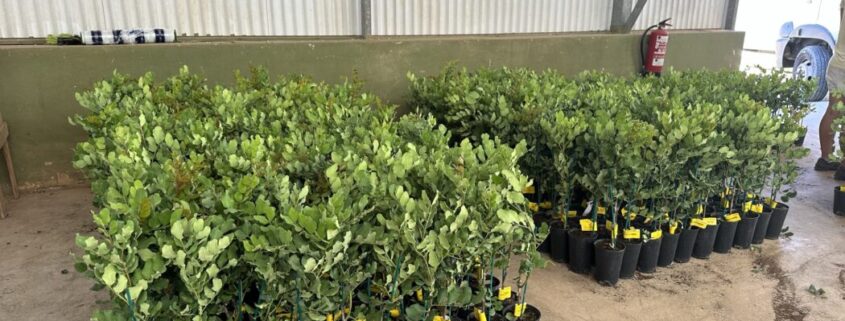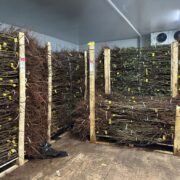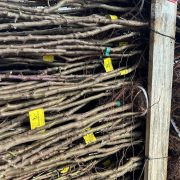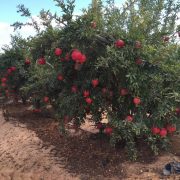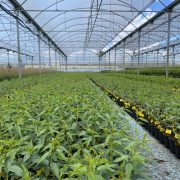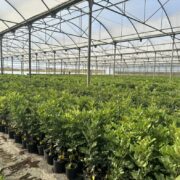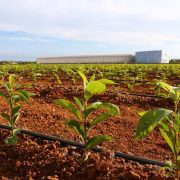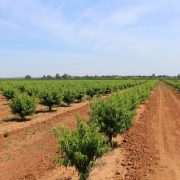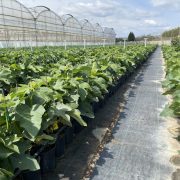Viveros Hernandorena leads the modernization of traditional carob tree cultivation to intensive irrigation
For more than a decade, Viveros Hernandorena has been developing an ambitious R&D research project, in collaboration with the Asociación Empresas Innovadoras de la Garrofa (EiG), focused on improving the quality of carob plants and the transformation of traditional cultivation to intensive irrigation.
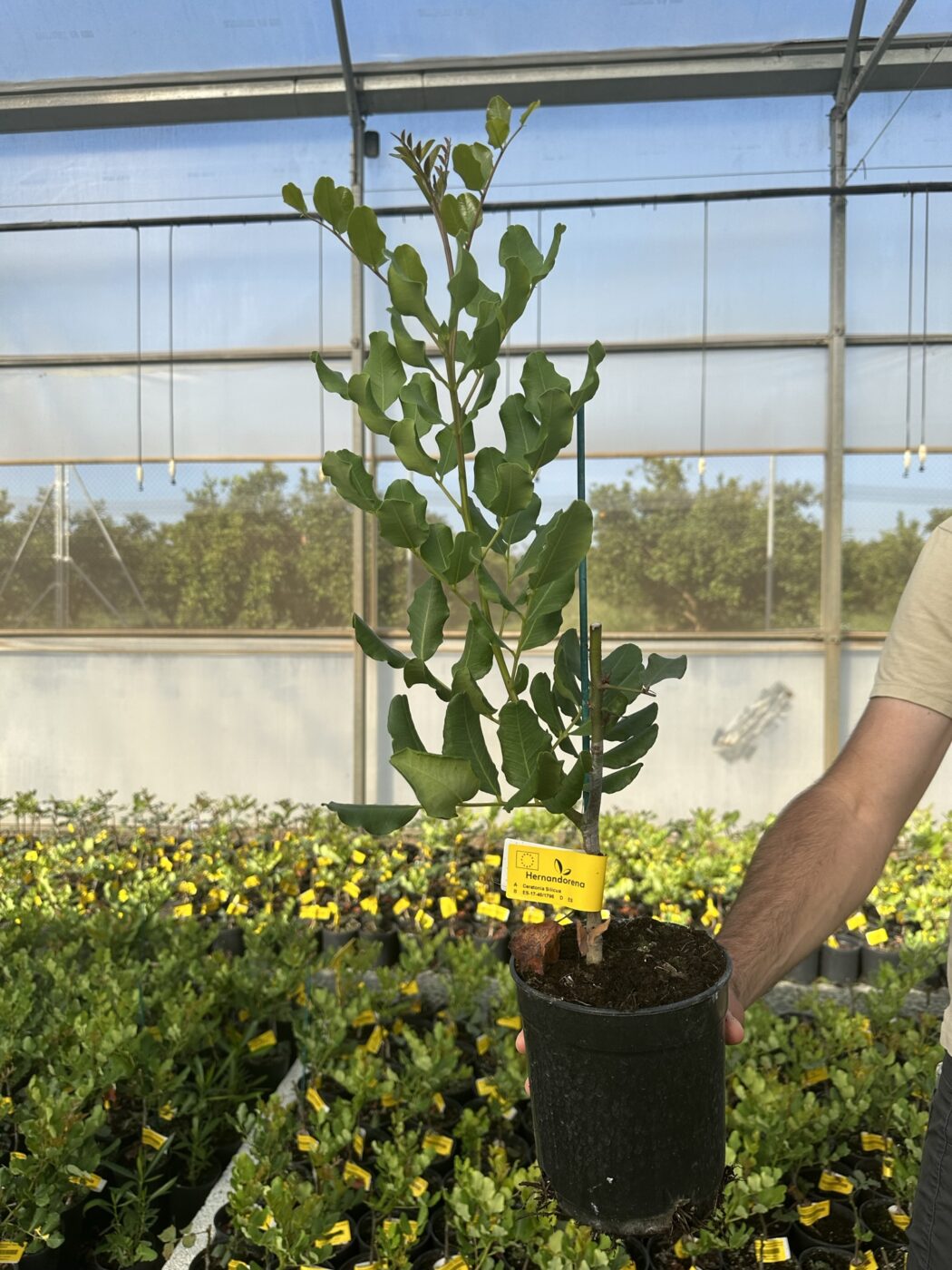
Planta de algarrobo injertado
Spain is the world’s leading producer and exporter of carob, mainly in pulp and locust bean gum, with an annual volume of between 60,000 and 80,000 tonnes of whole fruit and a surface area of 45,000 ha. The crop is mainly concentrated in the Valencia Region, the Balearic Islands and Catalonia, where the mild climate favours the well-being of this rustic crop, whose ageing, rain-fed plantations are giving way to new, more productive plantations with more efficient densities, achieving increasing profitability.
In a context of high demand for the valuation of products and by-products derived from carob, there is a shortage of carob on the market due to the progressive decrease in productive surface area over the last two decades, as a result of the grubbing up of plantations, competition from other more profitable crops and the advance of construction in coastal areas.
More than 10 years of research
Viveros Hernandorena’s commitment to the carob tree goes back a long way, anticipating the demands of producers, industry and consumers. In 2011, this nursery started up an experimental R&D project dedicated to the global improvement of this crop, in collaboration with the Association of Innovative Carob Tree Companies (EiG). “As a result of this alliance and our know-how, we have achieved significant improvements, both in the multiplication of trees grafted in the nursery and in the yields of new plantations. We are transforming the cultivation of carob from traditional rainfed to more efficient intensive irrigation,” says Rosa Hernandorena, commercial director of Viveros Hernandorena.
As a starting point for the project, the Association of Innovative Garrofa Companies carried out a research of varieties in different production areas on the Mediterranean coast until an optimum selection of rootstocks and both female and hermaphrodite varieties was achieved, of which Viveros Hernandorena already has its own mother trees.
In this sense, Viveros Hernandorena has been developing this plant material with innovative techniques of grafting multiplication and in vitro cultivation in its experimental field of three hectares, achieving optimisation and maximum efficiency in all the processes at an agronomic and technological level. The result of this technical and economic effort has been the obtaining of a tree of maximum quality and excellent qualities that brings forward its entry into production to the third green in some varieties.
Quality and crop management
Viveros Hernandorena manages the multiplication of carob trees with excellence, making an exhaustive pre-selection of the best plants at each stage of growth and management of the crop to guarantee the highest standards of the final product. The plants are grown in 1.5 litre pots, with a rojal selection of seed rootstock, the most homogeneous in force, implementing grafting and tutoring to obtain the highest productivity and efficiency.
The female varieties, Duraió and SDC, the most common in the Spanish Levante region, have greater vigour and high levels of production over time. The hermaphrodite varieties used are 13P, 14P and Turís, pollinators of medium vigour and also productive, with efficiency fluctuate between 14 and 18%. Planting is recommended after the summer, between September and October, to optimise the results in terms of plant grip and root development.
Another achievement to be highlighted lies in the early entry into production of the trees. While a traditional carob tree takes between eight and ten years to become productive, thanks to the new plant materials and management, Hernandorena has managed to develop trees that bear their first fruit after three years. “With these improvements, from obtaining between 3,000 and 4,000 kilos/ha, we aim to reach a minimum of 15,000 kilos/ha”, say the nursery, assuring that “greater productivity will lead to higher profitability in the plantations”.
In the field, the vast majority of carob tree plantations are characterised by their hardiness, with good adaptability to all types of land, low incidence of plague and low costs.
A competitive advantage of this rustic and eco-sustainable crop lies in its low water requirements, adapting well to drought and changing climatic conditions. According to Viveros Hernandorena, “this crop has enormous potential for areas where, either due to drought, low profitability of other crops or the incidence of plague, they are running out of agronomic options”.
Leaders in a minority crop
Thanks to their innovative approach, Viveros Hernandorena are true experts in this crop. They produce 80,000 rootstocks per year, from which they obtain more than 40,000 carob plants marketed. Their growth in this segment has been exponential in the last decade. “Our nursery is very well positioned in the cultivation of carob, we are the only nursery that develops different varieties with good plant quality and such a high and stable quantity of grafted trees”, they affirm from Hernandorena, emphasising their differential production system, which guarantees quality, health and subsequent adaptation to agricultural exploitation.
A powerful reason for implementing this crop is its high environmental value, contribution to the conservation of natural ecosystems and prevention of desertification. According to a report by the Association “Empresas Innovadoras Garrofa” (EIG), “carob has a high photosynthetic efficiency, ideal for absorbing CO2 from the atmosphere, with a positive net carbon balance, close to 5.4 mtC. These results suggest a promising potential for carob plantations to mitigate climate change,” says the report, which concludes that “in the future this crop could carry a ‘low-carbon’ label”.
High demand and healthy character
The low production of carob currently on the market contrasts with its high demand from industry, which uses it as an additive or raw material in food production. “The trend towards healthy food consumption has increased the demand for these much more natural raw materials”, emphasise Viveros Hernandorena.
From the carob pods, the seed or locust bean is extracted, from which locust bean gum is obtained, which is the thickener E-410. This “white gold” is highly valued, as it is the most sought-after natural thickener.
Carob pulp is also used to make flours, creams, drinks and other foods to which it contributes its highly nutritional properties. It is also a highly valued product for animal nutrition, as a raw material for animal feed, and for the cosmetics and pharmaceutical industries.
Thanks to its structure, nursery production development and logistics, Viveros Hernandorena guarantees a constant supply of carob plants throughout the year, leading the sustainable development of this healthy production for people and the planet.




